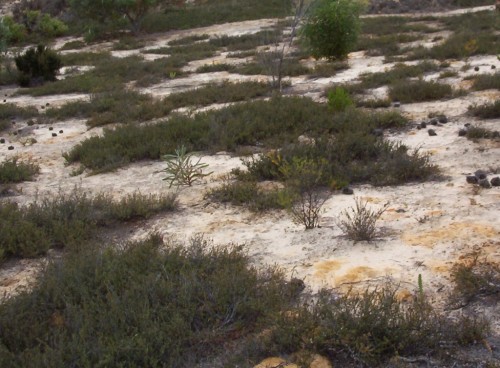New Eremophila Book
The post brought my new reference book on Eremophilas. This book by Bob Chinnock is a very new publication and people have been waiting for years for its arrival. There has been great interest in eremophilas because of their drought hardiness. Many have been described in other publications but some name changes have occurred and a number of sub species identified. Also included in the book is the related species Myoporum.
The book is calledÂ
Eremophila and allied genera, written by RJ Chinnock. Published in Australia by Rosenburg Publishing Pty Ltd.
Mine is a pre publication copy. The official publication date is 24th April 2007.
The blurb on the cover says it has taken 30 years of research to produce this book. I am looking forward to studying it. It is a very large book and some what technical but it is the descriptions that I am most looking forward to using.
More On Kunzea Pomifera (Muntries)
Kunzea pomifera (Muntries) In The Scrub
The photo shows some of the Kunzea pomifera (Muntries), that grow in this area. There were acres of the plants. The green patches on the ground are patches of Muntries. Very few weeds grow in the patches, just the occasional grasses. There were still berries on the plants and they were sweet to eat. I was surprised that the birds had not got to them all.
Australian Native Plants For 1st Line Coastal Plantings
I thought I would just list the plants from a list I have in an old book and not worry about their tolerance to alkaline soil. I can work on that list later.
Plants suitable for 1st line coastal planting.
Carpobrotus glaucescens
Carpobrotus modestos
Carpobrotus rossii
Disphyma crassifolia
Epacris stuartii
Frankenia angustipetala
Frankeniapauciflora
Hibbertia scandens
Ipomoea brasiliensis
Isolepis nodosa
Kennedia glabrata
Myoporum parvifolium
Pimelea ferruginea
Scaevola aemula
Scaevola calendulacea
Scaevola crassifolia
Scaevola pallida
Spinifex hirsutus
Swainsona lessertifolia
Thomasia petalocalyx
Zygophyllum billardieri
1st and 2nd Line Coast
The making of plant lists for these situations is trickier than I thought. Where does 1st line coast begin and end? The Australian Plant Society has decided that the sea front is 1st line coast. This could be a distance of 50-100 metres from the water. Plants that can be grown need to have tolerance to salt laden winds and salt soil. More tender plants could be planted with the protection of wind break plantings which are tolerant of 1st line coast conditions.
The second street back from the coast is the beginning of 2nd line coastal plantings. The further back from the coast the garden is, the plants can be less tolerant of the salt laden winds, especially with good protection from wind breaks or other barriers.
In some instances, the nature of the soil will also determine the plantings. For example, the soil could be rocky and gravelly, or pure sand dune sand.

